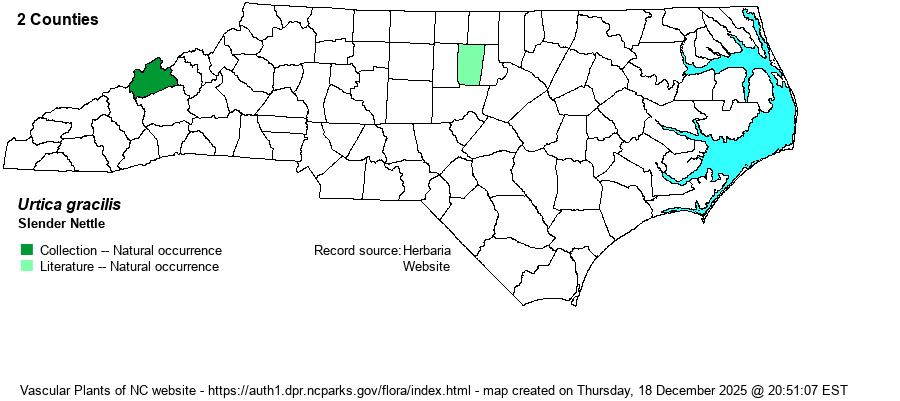| Author | Aiton | |
| Distribution | Known from one or more specimens from the Hot Springs area in Madison County, plus photos (and commentary) by A. Weakley on iNaturalist from Orange County. There is much confusion between this species -- strictly a North American one, and U. dioica -- a European one. Many references simply include the North American taxon as a subspecies of the European one.
This is a Northern species, considered by Weakley (2018) as distinct from the European species -- U. dioica; it ranges across southern Canada south to western NC, OH, northern TX, and AZ. | |
| Abundance | Very rare, known only from Madison and Orange counties; the sites are likely still current. The NCNHP's State Rank of SR (State Reported) is incorrect, as there is indeed at least one specimen. The website editors give a State Rank of S1, and recommend it be on the Significantly Rare list. | |
| Habitat | This species, in NC, is limited to sites over limestone (Madison County), and thus over high pH soil; soil and habitat for the Orange County plant(s) was not reported. Over its range, it favors rich alluvial soil of floodplains. | |
| Phenology | Blooms from May to July, and fruits from July to September. | |
| Identification | This is an erect herb with few to no stinging hairs on the stem, which is usually unbranched; it can grow to 3-4 feet tall. The stem leaves are opposite, lanceolate to narrowly ovate in shape, with a short petiole, serrated margins, and about 3-4 inches long and about 1.5 inches wide. The leaf base is truncate to rounded, and the leaves are usually devoid of stinging hairs. The flowers are in clusters in leaf axils, usually linear and somewhat drooping, about 1-2 inches long. The similar U. dioica has the stems branched, usually weak and sprawling, with an abundance of stinging hairs on the branches and main stem. Also, it has the leaves strongly hairy with stinging hairs on both surfaces, and the teeth on the margin are usually 1/5-inch inch long, as opposed to only 1/8-inch long in U. gracilis. | |
| Taxonomic Comments | See above. Some confusion comes from the fact that, in Madison County, the exotic U. dioica has also been collected in the Hot Springs area.
| |
| Other Common Name(s) | California Nettle. "Stinging Nettle" is the common name for Urtica dioica, and would be in use if U. gracilis were included within that species. | |
| State Rank | [S1] | |
| Global Rank | G5 | |
| State Status | [SR] | |
| US Status | | |
| USACE-agcp | | |
| USACE-emp | | |

